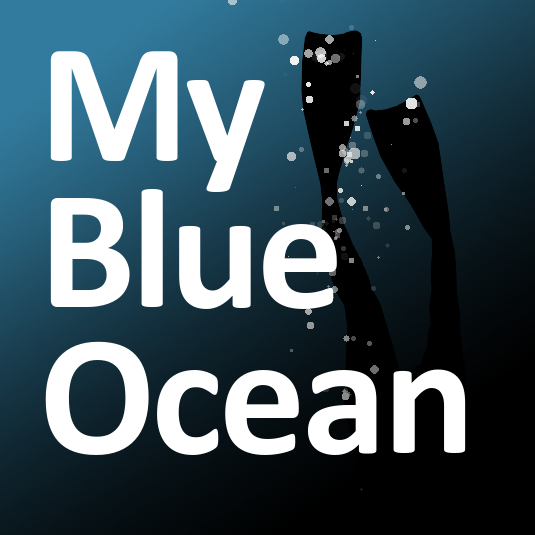Under water in croatia in the moonlight – Unterwasser in Kroatien im Mondlicht

We’re still in Istria on the Adriatic coast and want to go night snorkeling once again! Such a decision is quickly made during the warm sunshine of the day. But at 9pm in the dark cold night we hesitate and think about our plan. But in the end we leave the warm and cosy camper. Highly motivated we peel ourselves into the still wet and cold diving suits of the day-snorkel. A little bit of wind is blowing, but as soon as we are in the suits we can’t feel it anymore. Our bodies quickly heat the suits. Yes, we are snorkeling semmi-dry. Then we decorate ourselves with various cameras and loads of extra lights: a few dive lights and two camera lights. Our camper neighbour Eva is still awake and we tell her what we are up to and where the search party must look in the case that we don’t make it 😉 Then we’re off into the dark wet frontier. Not so cold after all. The entry point is stony and a bit slippery due to small algae. So we quickly slip into our fins and float on the water. That was a good idea, just a bit further we spot the first two large Scorpionfish. They are night active fish that are poisonous and so close to shore! Have a look at some of the other creatures of the night we found. Some well asleep, others on the prowl for food! After a good hour in the ocean and a very hot shower afterwards to warm up, we finally crawl back into our beds and also switch from night active to a good night sleep.
🚑….
Wir sind noch in Istrien, an der Adria und wollen mal wieder nachts schnorcheln! Am Tag im schönsten warmen Sonnenschein trifft sich so eine Entscheidung immer ganz leicht. Doch so gegen 21 Uhr und finsterer, kalter Nacht zögern wir ganz kurz, ob wir es wirklich tun. Schließlich verlassen wir hoch motiviert unseren warmen Camper und pellen uns in die noch vom Vortag leicht feuchten Neoprenanzüge. Es weht ein leichter Wind, den wir im Neo aber nicht mehr spüren. Wir erwärmen die Anzüge auch sogleich mit unserer Körperwärme. Ja wir gehen im Halbtrocki ins Wasser! Dann behängen wir uns mit Kameras und jeder Menge extra Lampen: mehrere Taschenlampen sowie zwei Photolichter. Wir sagen noch schnell unserer netten Camping-Nachbarin Eva Bescheid, damit jemand weiß, wo gesucht werden muss, falls wir nicht wieder kommen sollten 🙂 Dann trauen wir uns hinein ins dunkle Nass, ist auch gar nicht sooo kalt… Der Meereseinstieg ist steinig und durch kleine Algen etwas rutschig, also ziehen wir sehr schnell die Flossen an und legen uns ins Wasser. Das erweist sich als eine sehr gute Maßnahme, denn nach circa. zwei Metern treffen wir im sehr flachen Wasser zwei nachtaktive Drachenköpfe an, welche zu den giftigen Fischen gehören! So nah am Ufer! Schaut Euch an, welche Wesen wir noch getroffen haben, nachtaktiv – oder schlafend! Nach einer guten Stunde im Wasser und einer heißen Dusche krabbeln wir unters Federbett und wechseln unseren Modus von nachtaktiv auf schlafend 😀

Auffällig des nachts sind wieder jede Menge Ährenfische, welche im Flachwasser tief schlafen, so dass wir mit der Taschenlampe fast dagegen stoßen. Tagsüber sehen wir sie selten. Höchstens frittiert als Atherina im Restaurant 🙂

Tadaa! Wir hatten uns sehr gut gemerkt, wo wir am Tag zuvor den großen Meeraal in seinem Felsversteck entdeckten. Dieses wollten wir in der Dunkelheit wiederfinden. Doch der Bewohner geht aus und begrüßt uns auf dem Weg! Später sehen wir noch einen zweiten etwas kleineren Meeraal.

Dieser Schriftbarsch pennt tief und fest. Obwohl wir ihn anleuchten und fotographieren, zieht er sich nicht zurück. Wir lassen ihn auch sogleich weiterschlafen.

Diese süße Grundel guckt einfach nur zurück, ohne Scheu.

Endlich Tintenfische!! Erinnert ihr euch an die bei Tag im Sand vergrabene Sepie? Kein Wunder, denn Sepien sind auch nachtaktiv und diese hier konnten wir eine Weile beim Jagen beobachten.

Diese Sepien trefen wir etwas später an und sie lässt uns auch erstaulich nah an sich heran. Sie gleitet entspannt über den Meeresboden und ihr Flossensaum flimmert hübsch im Schein unserer Taschenlampen.

Über Sandgrund sind wir immer sehr motiviert, denn hier verstecken sich manchmal verdammt gut getarnte mini Sepien, nur einige Zentimeter klein. Sie werden auch Stummelschwanzsepien genannt, sehr charmant! Diesmal haben wir Erfolg und eine entdeckt!

Die Schnecke haben wir nach langem Suchen als Gefleckte Berthella (Berthella ocellata) bestimmt. Sie kommt eigentlich eher im westlichen Mittelmeer bis zu den Kanaren vor, es gab aber in Kroatien schon mehrere Sichtungen.

Große Steckmuscheln stehen unter Schutz, wir sehen glüclicherweise einige davon. Sie sind die größten Muscheln des Mittelmeeres und können bis zu 1m groß werden! Auf dieser hier haben es sich auch zwei Austern bequem gemacht. Hoffentlich beeinträchtigen die Austern die Steckmuscheln nicht!

Auch diese Seegurke snackt. Diese Seeguke an sich ist vergraben, aber die Tentakel fangen kleine Lebewesen. Ein Arm nach dem anderen verschwindet im Mund und wird abgelutscht. Aber nicht reihum, wir konnten kein Muster feststellen 😉







